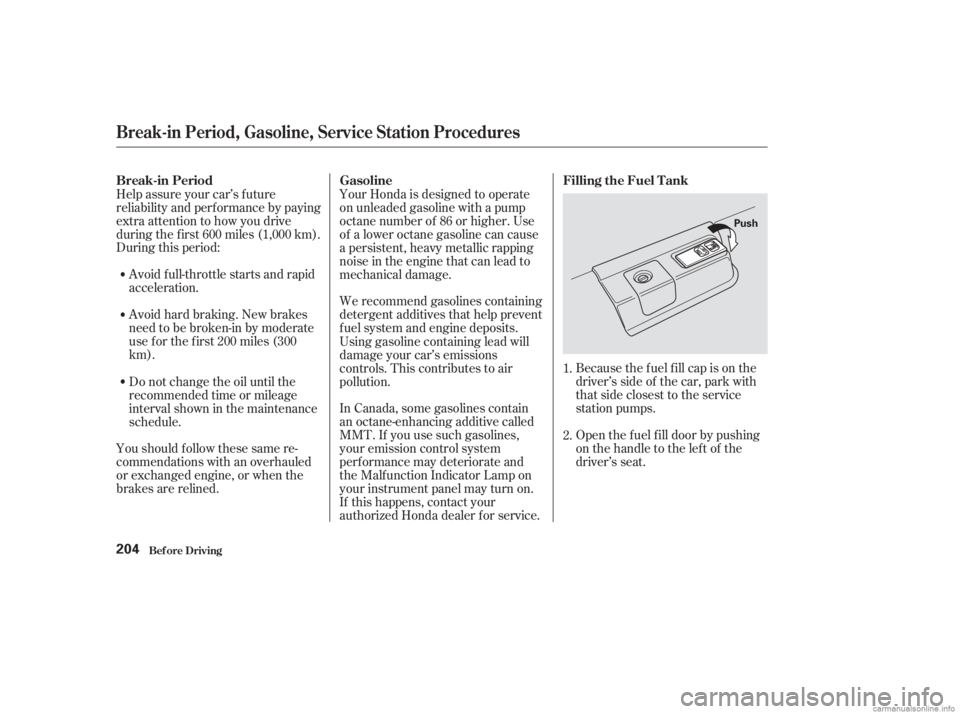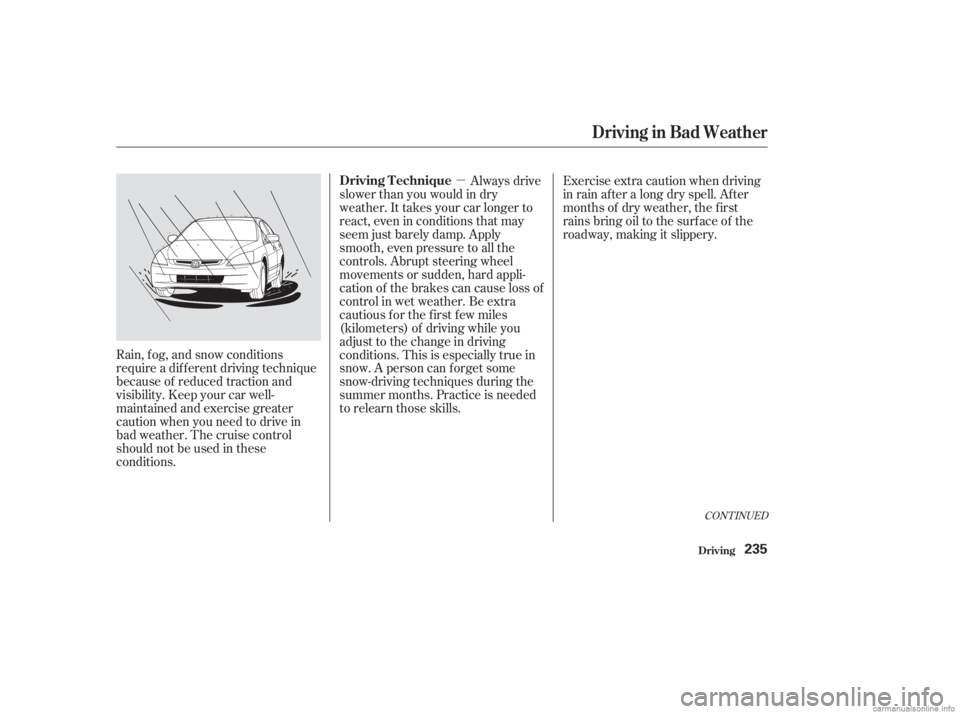Page 55 of 395

Your car’s exhaust contains carbon
monoxide gas. You should have no
problem with carbon monoxide
entering the car in normal driving if
you maintain your car properly.
Have the exhaust system inspected
f or leaks whenever:The car is raised f or an oil change.
You notice a change in the sound
of the exhaust.
Thecarwasinanaccidentthat
may have damaged the underside. If you must sit in your parked car,
even in an unconf ined area, with the
engine running, adjust the heating
and cooling system as f ollows: With the trunk lid open, air f low can
pull exhaust gas into your car’s
interior and create a hazardous
condition. If you must drive with the
trunk lid open, open all the windows
and set the heating and cooling
system as shown below.
High levels of carbon monoxide can
collect rapidly in enclosed areas,
such as a garage. Do not run the
engine with the garage door closed.
Even with the door open, run the
engine only long enough to move the
car out of the garage. Select the Fresh Air mode.
Select the mode.
Turn the f an on high speed.
Set the temperature control to a
comfortable setting.
1.
2.
3.
4.
Carbon Monoxide Hazard
Driver and Passenger Saf ety52
Carbon monoxide gas is toxic.
Breathing it can cause
unconsciousness and even kill
you.
Avoid any enclosed areas or
activities that expose you to
carbon monoxide.
Page 60 of 395
The U.S. instrument panel is shown. Dif f erences f or the Canadian models are noted in the text.
Indicator L ights
Inst rument s and Cont rols57
CRUISE CONTROL INDICATOR
LOW FUEL INDICATOR LIGHT ON INDICATOR
SEAT BELT REMINDER LIGHT MAINTENANCE REQUIRED
INDICATOR
HIGH BEAM INDICATOR
MALFUNCTION
INDICATOR LAMP TRACTION CONTROL SYSTEM
INDICATOR
CRUISE MAIN INDICATOR ANTI-LOCK BRAKE SYSTEM
INDICATOR
PARKING BRAKE AND BRAKE
SYSTEM INDICATOR TCS ACTIVATION INDICATOR
LOW OIL PRESSURE
INDICATOR (P.58)
CHARGING SYSTEM
INDICATOR (P.62)
(P.62)
DOOR MONITOR
SECURITY SYSTEM INDICATOR SUPPLEMENTAL
RESTRAINT SYSTEM
INDICATOR
(P.58)
(P.59)
(P.
59)
(P. 62)
(P.61)
(P. 61) (P.
59)
(P.
65)
(P.60)
(P. 58)
(P.61)
(P.58)
(P.58) (P.60)
IMMOBILIZER SYSTEM INDICATOR (P.62)
(P.59)
SIDE AIRBAG CUTOFF
INDICATOR
Page 61 of 395

The instrument panel has many
indicators to give you important
inf ormation about your car.
This indicator lights when you turn
the ignition switch ON (II). It is a
reminder to you and your passengers
to protect yourselves by f astening
the seat belts. A beeper also sounds
if you have not fastened your seat
belt.
If you do not f asten your seat belt,
the beeper will stop af ter a f ew
seconds but the light stays on until
you do. Both the light and the beeper
stay of f if you f asten your seat belt
bef ore turning on the ignition.The engine can be severely damaged
if this light f lashes or stays on when
the engine is running. For complete
inf ormation, see page .
If this light comes on when the
engine is running, the battery is not
being charged. For complete
inf ormation, see page .
See page .
This light has two f unctions:
This indicator comes on when you
turn the ignition switch ON (II). It
is a reminder to check the parking
brake. Driving with the parking
brake not f ully released can
damage the brakes and tires.
If the indicator remains lit after
you have f ully released the
parking brake while the engine is
running, or if it comes on while
driving, it can indicate a problem
in the brake system. For complete
inf ormation, see page .
1.
2.
347
348
349
351
Indicator L ights
Inst rument s and Cont rols
Seat Belt Reminder L ightL ow Oil Pressure
Indicator
Charging System
Indicator
Malf unction Indicator
LampParking Brake and Brake
System Indicator
58
U.S. Canada
Page 206 of 395
Bef ore you begin driving your Honda,
youshouldknowwhatgasolineto
use, and how to check the levels of
important f luids. You also need to
know how to properly store luggage
or packages. The inf ormation in this
section will help you. If you plan to
add any accessories to your car,
please read the inf ormation in this
section f irst..............................
Break-in Period .204
.........................................
Gasoline .204
.........
Service Station Procedures . 204
................
Filling the Fuel Tank . 204
....................
Opening the Hood .206
...............................
Oil Check .208
.........
Engine Coolant Check . 210
...............................
Fuel Economy .211
............................
Car Condition .211
...........................
Driving Habits .211
...
Accessories and Modif ications . 212
.............................
Carrying Cargo .214
Bef ore Driving
Bef ore Driving203
Page 207 of 395

During this period:Avoid full-throttle starts and rapid
acceleration. We recommend gasolines containing
detergent additives that help prevent
f uel system and engine deposits.
Avoidhardbraking.Newbrakes
need to be broken-in by moderate
use f or the f irst 200 miles (300
km).
Open the f uel f ill door by pushing
onthehandletotheleftof the
driver’s seat.
Help assure your car’s f uture
reliability and perf ormance by paying
extra attention to how you drive
during the f irst 600 miles (1,000 km).
Because the f uel f ill cap is on the
driver’s side of the car, park with
that side closest to the service
station pumps.
In Canada, some gasolines contain
an octane-enhancing additive called
MMT. If you use such gasolines,
your emission control system
perf ormance may deteriorate and
the Malf unction Indicator Lamp on
your instrument panel may turn on.
If this happens, contact your
authorized Honda dealer f or service. Using gasoline containing lead will
damage your car’s emissions
controls. This contributes to air
pollution.
Youshouldfollowthesesamere-
commendations with an overhauled
or exchanged engine, or when the
brakes are relined. Do not change the oil until the
recommended time or mileage
intervalshowninthemaintenance
schedule. Your Honda is designed to operate
on unleaded gasoline with a pump
octane number of 86 or higher. Use
of a lower octane gasoline can cause
a persistent, heavy metallic rapping
noise in the engine that can lead to
mechanical damage.
1.
2.
Bef ore Driving
Break-in Period GasolineFilling the Fuel Tank
Break-in Period, Gasoline, Service Station Procedures
204
Push
Page 211 of 395
Check the engine oil level every time
you f ill the car with f uel. Wait a f ew
minutes af ter turning the engine of f
bef ore you check the oil.Remove the dipstick. Wipe the dipstick with a clean
cloth or paper towel.
1. 2.
Service Station Procedures
Bef ore Driving
Oil Check
208
4-cylinder models
6-cylinder models
DIPSTICK
(Orange Handle)
DIPSTICK
(Orange Loop)
Page 212 of 395
CONT INUED
Insert it all the way back in its tube.Remove the dipstick again and
check the level. It should be
between the upper and lower
marks.
If it is near or below the lower mark,
see on page .
3.
4.
268
Service Station Procedures
Bef ore Driving
A dding Oil
209
6-cylinder models UPPER MARK
LOWER MARK
4-cylinder models 4-cylinder models
Page 238 of 395

�µ
CONT INUED
Rain, f og, and snow conditions
require a dif f erent driving technique
because of reduced traction and
visibility. Keep your car well-
maintained and exercise greater
caution when you need to drive in
bad weather. The cruise control
should not be used in these
conditions.Always drive
slower than you would in dry
weather. It takes your car longer to
react, even in conditions that may
seem just barely damp. Apply
smooth, even pressure to all the
controls. Abrupt steering wheel
movements or sudden, hard appli-
cation of the brakes can cause loss of
control in wet weather. Be extra
cautious f or the f irst f ew miles
(kilometers) of driving while you
adjust to the change in driving
conditions. This is especially true in
snow. A person can f orget some
snow-driving techniques during the
summer months. Practice is needed
to relearn those skills. Exercise extra caution when driving
in rain af ter a long dry spell. Af ter
months of dry weather, the f irst
rains bring oil to the surf ace of the
roadway, making it slippery.
Driving in Bad Weather
Driving
Driving T echnique
235